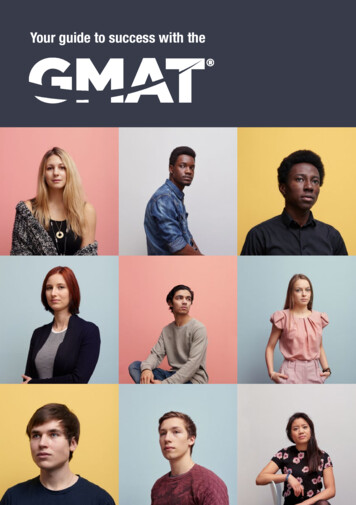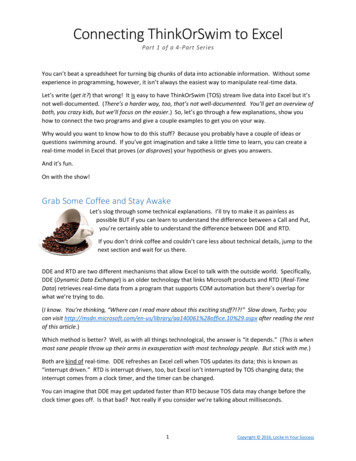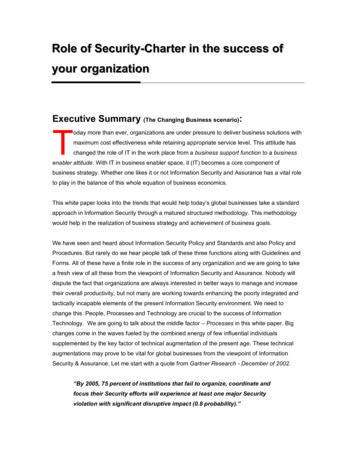
Transcription
Your guide to success with thei
The GMAT at a glance 2Why should you take the GMAT exam? 4How is the GMAT relevant to business school and beyond 8The GMAT exam structure 13What to expect on test day 21Your GMAT score 27Sample questions 34Your action plan 42
250,00011050540–550GMAT exams were taken around the worldin 2015Approximate number of countries whereGMAT scores are acceptedThe approximate number of people whoachieve a perfect score of 800 each yearAverage GMAT scores typically fall inthis range6001954CATApproximate number of official test centresgloballyThe year the exam was created by agroup of top US business schools to bea standardised entrance exam for graduatemanagement masters programmesNot your feline friend. CAT or Computer Adaptive Testing automatically adapts theGMAT questions based on your performance in the Verbal and Quantitative sectionsApproximate number of graduate businessprogrammes around the world that acceptor require GMAT exam3½ hrs20%The length of time you have to completethe GMAT examThe proportion of candidates who takethe GMAT more than onceGMAC90–100 hrsmba.comThe not-for-profit Graduate Management Admission Council. Represents the interestsof business schools and their students, and oversees the GMAT examPreparation undertaken by GMAT takerswho achieve scores of 600 to 700The official website to visit for study tips,practice material and to book your test5 yearsTax800How long your score remains validApplies in some countries, see mba.comfor detailsThe maximum GMAT score you canachieve31 2504EnglishThe average points gain for GMATre-takersThe cost of the examThe number of sections in the examThe language all GMAT exams aredelivered in6,50023
Why should you takethe GMAT exam?The GMAT is the most widely used examfor graduate business degree admissions.Laura MattioliWhere did you grow up? Lugano, SwitzerlandWhat do you love? Writing, writing, writingLast live event? Disclosure concert in LondonWhat one piece of advice can you give to otherswho are thinking about taking the GMAT? Take yourtime to study: don’t be lazy and leave it all forthe end, start preparing yourself earlier. This willmake your journey to the exam much more relaxed.45
You’ll gain a competitive advantageThe GMAT exam levels the playing fieldUnlock scholarship fundingThe GMAT exam is the most widely usedindicator of academic success in graduatebusiness degree programmes. Taking thetest clearly signals to admissions managersthat you are serious about earning a degreeand succeeding on their programme.As a globally recognised, standardisedtest, your GMAT score puts you on a levelplaying field with candidates from around theworld. It also allows you to compete fairlyagainst other candidates with widely varyingacademic and professional backgrounds.Many business schools and universitiesoffer scholarships to their graduate businessstudents, on the basis of need, diversityor merit. A good GMAT score is often partof the qualification criteria for scholarshipsand bursaries, which should be applied forearly in the admissions cycle. Find out moreabout funding your programme by visitingmba.com/funding.Secure a place on your programme ofchoiceGMAT questions measure your criticalreasoning skills, the skills that are highlyrelevant to the world’s best graduatebusiness programmes. When you performwell on the GMAT exam, you demonstratethe commitment, motivation, and abilityto succeed in business school.Open doors with a strong scoreApplying to a programme with a strongGMAT score gives you confidence thatyou’ll be studying alongside equally talentedstudents. Upon graduation, they will becomea valuable part of your network throughoutyour career.Why should I take the GMATexam if it’s not compulsory for theprogramme I am applying for?We highly recommend that you speakwith the admissions team for your chosenprogramme well ahead of the admissionsdeadline. Even when the GMAT is not acompulsory part of the application6Elevate above the restA graduate business degree empowersyou to succeed by increasing yourearning potential and unlocking a world ofopportunities. The journey starts with theGMAT exam.Help the right programmes find youChoose to opt-into the GMASS (GraduateManagement Admission Search Service )database and your strong GMAT scorecan help you get noticed by the businessschools and universities that are the right fitfor you. This opens you up to new options,from programmes you may have countedyourself out from or those that are deliveredin formats or locations you might not haveconsidered.process up front, admissions managersmay still ask you to supply a score laterin the process if your application is notas competitive as others in their applicantpool. Also consider whether the GMAT isrequired for your second or third choiceprogrammes if you are not able to securea place on your first choice programme.When should I take the GMATexam?Check the admissions deadlines for yourtarget programme(s) well ahead of timeand work back from there, accounting forhow much time you need to prepare. Werecommend preparing for the GMAT at leastsix months ahead of time to give yourselfthe chance to achieve the score you want,or to re‑take if you want to aim for a higherscore. Your GMAT score is valid for five years.If you are currently studying, preparing forthe GMAT while you are still in an academicmindset can make your life significantlyeasier. Take advantage of your study routineas finding time to fit in test preparation canbe hard when you’ve started working. If youare an experienced professional consideringa part-time programme or an Executive MBA,studying for the GMAT gives you valuableinsights into how you can balance workand study with a busy social and family life.Remember, admissions managers appreciatecandidates who have taken their test earlyand have prepared well for it. It means theydon’t have to wait for your score to comethrough or for you to schedule a resit. Itshows them that you are committed, knowwhat you need to do and are prepared towork hard to achieve success.7
How is the GMAT relevant to businessschool and beyond?Over six decades, the GMAT exam has beenenhanced and refined so that it continuesto measure the key indicators of successthat are prized by admissions managers,professors and employers.Djae AroniWhere did you grow up? Nairobi, KenyaWhat do you love? Playing guitar and discoveringnew music. And cats, I love cats.Best gig? Rocktoberfest Nairobi, 2012Your favourite quote? ‘When things get heavy justcall me helium, the lightest gas known to man.’Jimi Hendrix8
Sharpen the skills required forsuccess in schoolThe GMAT is developed and updated withinput from the world’s leading businessschools. By sharpening your skills as youprepare for the exam, you’ll be able toearn a strong score and thrive in businessschool and the business world.The exam provides an accurate andobjective measure of your ability to: Think critically and apply your higherorder reasoning skills Analyse and make decisions based ondata from multiple sources Write clearly and effectively Study and perform academically Remain focused for an extendedperiod of time Solve problems Evaluate arguments and take aninformed position Prioritise time and effort, and performunder intense time pressureBy developing these abilities through yourGMAT prepa rations, you’ll be equippingyourself with a highly marketable set of skillsthat you’ll be able to draw on again and again.It’s not rocket science GMAT questions are based on themathematic concepts and English-languageskills you would have learnt in secondaryschool to the age of 16. For example, youwill likely be required to use arithmetic,elementary algebra and geometry as part ofthe test. The GMAT does not evaluate yourbusiness knowledge, job skills, motivation orinterpersonal skills. It is also not designed totest your command of the English language.You already have what it takes to achievea good result on the GMAT. It’s essential thatyou understand that preparation is crucial. but you need to prepareThe GMAT is not impossibly challenging.However, it is exceedingly difficult to geta good, balanced score that truly representsyour abilities without knowing what toexpect by reviewing practice questions andpreparing for the test conditions.While the English and mathematicsinvolved are not especially difficult, theGMAT is measuring your ability to reasonand make complex judgments using criticalthinking, analysis of information, andproblem solving under timed conditions.Aram KarakasWhere did you grow up? Vancouver, BCWhat do you love? Hockey, foodBest job? Researcher at British Columbia Centrefor Excellence in HIV/AIDS.What one piece of advice can you give to others whoare thinking about taking the GMAT? Study hard,have fun, enjoy it and think big picture.1011
The GMAT exam structureThe Graduate Management Admission Testis unlike any test you have taken before.Knowing what to expect and what is beingassessed is a key part of your preparation.Ekaterina VoloshchenkoWhere did you grow up? Moscow, RussiaWhat do you love? Reading, ice skatingWhat superpower would you have? LevitationWhat one piece of advice can you give to otherswho are thinking about taking the GMAT? Prepareas much as you can in good time before the test.1213
The GMAT exam structure1.AnalyticalWriting91 questions 200–800 points 4 hrs approxfinishs ta rtDuration: 00:301 question0–6 pointsThe GMAT exam is conducted entirely inEnglish and is administered on a computer ata GMAT approved test centre. You will onlysee one question at a time and you cannotskip or go back. The questions are dividedinto four compulsory, separately timedsections, with two optional timed breaks.2.IntegratedReasoningkDuration: 00:3012 questions1–8 pointseabrDuration: 01:1541 questions0–60 pointscomputer adaptivebreak4.VerbalReasoningTo ensure fairness, all test takers aroundthe world: are evaluated on the same numberof questions answer the same type of questions are subject to the same time limits are tested in similar conditions.Visit mba.com/GMATformat formore insights into the formatand timing3.QuantitativeReasoningDuration: 01:1537 questions0–60 pointscomputer adaptive15
1. Analytical WritingThe GMAT exam begins with the AnalyticalWriting Assessment. This 30-minute writingtask measures your ability to analyse thecomplexities of an argument and formulatea well-reasoned critique.You will be asked to write an essay inresponse to one Analysis of an Argumentquestion. The question will concern atopic of general interest and may relate toa business topic or some other subject.However, it presupposes no specificknowledge of business or any othercontent areas. Only your capacity to writeanalytically is assessed.In the Analytical Writing Assessment,you should demonstrate your ability to: Identify and think critically aboutthe key elements of the argument Communicate your ideas clearly andlogically Formulate an appropriate andconstructive response Use your command of the Englishlanguage.The Analytical Writing Assessment does not testfor perfect English, only your ability to use Englishto analyse the argument presented and to write awell-articulated response. Additionally, you are notasked to present your own views on the topic.2. Integrated ReasoningThe Analytical Writing Assessment isfollowed by the 30-minute IntegratedReasoning section. This part of the GMATexam is designed to mimic today’s business16world that demands managers synthesisedata from multiple sources to identifypatterns, make decisions and solve businessproblems.There are 12 multiple response questionsin the Integrated Reasoning section usingfour different question formats:Multi-Source Reasoning Using data frommultiple sources, you answer multiplechoice or yes/no and true/false questions.Table Analysis Using a sortable tablecontaining numeric data, you mustdetermine if a set of statements aretrue or false.Graphic Interpretation Using a chart orgraph, you find or extrapolate a value tocomplete fill-in-the-blank statements froma drop-down list.Two-Part Analysis Using quantitativeand/or verbal information, you must weightrade-offs and make decisionswith more than one variable. Possibleanswers are presented in a table andyou should choose the correct options.In the Integrated Reasoning section ofthe GMAT, you should demonstrate yourability to: Understand and evaluate multiplesources and types of information –graphic, numeric and verbal – as theyrelate to one another Use quantitative and verbal reasoningto solve complex problems Solve multiple problems in relation toone anotherAdvanced statistical and spreadsheetmanipulation skills are not necessary.A basic on-screen calculator is providedfor this section, but is not available onthe Quantitative section.The Integrated Reasoning section isnot computer adaptive and does notcount towards your Total GMAT score.choice questions. You have approximatelytwo minutes to answer each question. It isalso the first computer adaptive section ofthe GMAT exam.The questions in this section are a mixof problem solving and data sufficiencyquestions, and require common knowledgeof concepts related to arithmetic, elementaryalgebra, geometry and word problems.3. Quantitative Reasoning4. Verbal ReasoningAfter a short break, you move on to theQuantitative Reasoning section. This sectionof the exam tests your ability to reason, solveproblems and interpret data. It measuresthe skills you will use in quantitative-basedsubjects such as finance, accounting andmanagerial statistics.The Quantitative Reasoning section lastsfor 75 minutes and includes 37 multipleAfter the Quantitative Reasoning section, youcan have another short break before movingon to the final section of the GMAT exam,Verbal Reasoning. The Verbal Reasoningsection assesses your ability to comprehendand draw inferences from written material, toevaluate arguments, and to make correctionsto conform to standard written English.You have 75 minutes to complete theWhat is Computer Adaptive Testing?This is why you only see one question ata time and you cannot skip or go back.You are also severely penalised if you donot complete all questions in the timeprovided. It is therefore better to eliminateas many options as you can, before makingyour best guess and moving on to the nextquestion. It is important to remember thatif you get a question that seems easier thanthe last one, it does not necessarily meanyou answered the last question incorrectly.We include additional questions in your setfor calibration and quality purposes thatare not subject to the adaptive process.The GMAT is more than just a computerisedversion of a written test, it is computeradaptive. This means it automatically adaptsthe question you see in the Quantitative andVerbal Reasoning sections based on a realtime assessment of your performance asyou are taking the test. The Quantitative andVerbal sections both start with moderatelydifficult questions. The more questionsyou answer correctly, the more difficultthe questions become and the higher yourpotential score can be. The opposite isalso true.17
Verbal Reasoning section, which includes41 multiple-choice questions. You haveroughly one and three quarters of a minute tological relationships between elementsof the contentCritical reasoning measuring your abilityReading comprehension passages of up to 350words are followed by a set of questionstesting your ability to interpret the text,to draw inferences from it, and to identifyWhile the GMAT is not designed to test yourEnglish language skills, you will require agood understanding of standard writtenEnglish to be able to understand and answerthe questions in this section.answer each question. Like the QuantitativeReasoning section, this partof the GMAT exam is computer adaptive.This section features a mixture of threetypes of multiple choice questions:to draw conclusions from short argumentsSentence correction choosing the phrasethat completes a sentence with the mostgrammatical accuracy.Adeyemi GafaarWhere did you grow up? Lagos and Abuja, NigeriaWhat do you love? Travelling with my familyBest gig? Ed SheeranFavourite quote? ‘I am the master of my fate, I amthe captain of my soul.’ William Ernest HenleyWhat one piece of advice can you give to otherswho are thinking about taking the GMAT? Relax!Especially the night before; have a good nights rest.18
What to expect on test dayPrepare to take the GMAT with confidenceby learning what to expect on the day ofthe exam.Jenny TranWhere did you grow up? GermanyWhat do you love? DancingBest gig? Rave in a bamboo forest near ShanghaiWhat one piece of advice can you give to others whoare thinking about taking the GMAT? Study hard, butdon’t stress out too much – it will all turn out fine.2021
Arriving at the test centreIn the test roomWith the exam lasting three and a half hoursplus additional time for travel, check-in,breaks, and check-out, your GMAT test daycan be a long one. Make sure you come wellprepared, consider, perhaps bringing somehealthy snacks to eat during the breaks tokeep your energy and concentrationlevels up.Arrive at least 30 minutes before the startof your test to give you plenty of time topass through our secure check-in process.Our high level of security and standardisedtesting conditions are some of the reasonsthe GMAT is so well trusted by admissionsmanagers around the world.On arrival, you will be asked to presentyour photo ID. Acceptable forms of IDinclude a passport or driving licence. Forsome test takers, a passport is the onlyallowable ID. See mba.com for a full andup-to-date list of accepted ID in your testcountry. Your name and date of birth onyour ID must match their records and yourappointment confirmation letter exactly.An administrator at the test centre thentakes a digital photograph and/or signature,as well as digital scans of your palm veinpattern. These are used for fraud detectionand prevention purposes.You will be allocated a locker prior toentering the testing room where you canstore your belongings, including your coat,bag, watch and mobile phone. You are notpermitted to take anything into the testroom, other than prescription glasses anda cardigan or jumper.GMAT exam rooms have a number of privatecomputer workstations and may be subjectto audio/video recording. You will be loggedinto a terminal by a test administrator andnoteboards, pens and ear plugs will beprovided.Before you can start the test, you mustread and digitally sign the Testing Rules andAgreement for the country in which the testis being delivered. By doing this, you agreeto promise to not share anything you seewith anyone else and that you are taking thetest for the purposes of applying to graduatemanagement programmes.Finally, you are asked to select up to fiveprogrammes that you would like to have yourGMAT score sent to, free of charge. If youwant to have your score sent to more thanfive programmes, or if you wish to choosethe programmes later, you will be required topay an additional 28 per programme.Visit mba.com/testday for more insights into theGMAT test experience22During your testYou have three and a half hours in which tocomplete the GMAT, but you should planto be at the test centre for approximatelyfour hours in total. You can take twooptional, eight minute breaks and we highlyrecommend that you use these. If youexceed the time allowed for these breaks,the excess time is automatically deductedfrom the time you have left to complete thenext section of the test.You are not allowed to eat or drink in thetest room, but you can access food anddrink during the scheduled breaks. Accessto electronic devices, such as mobile phonesor calculators, or your study notes, is notpermitted at any time while you are in thetest centre, even during breaks.You are not permitted to leave thetesting room without the test administrator’spermission, even during breaks. You aregener
a part-time programme or an Executive MBA, studying for the GMAT gives you valuable insights into how you can balance work and study with a busy social and family life. Remember, admissions managers appreciate candidates who have taken their test early and have prepared well for it











